Using SPARQL Optionals
5 likes8,102 views
OPTIONAL patterns in SPARQL allow for expressing optional conditions in queries over graph data. OPTIONAL patterns extend the results of preceding patterns and can provide bindings for variables even if they are not bound earlier. Nested OPTIONALS are evaluated left-to-right. Disconnected OPTIONALS result in a cross product. OPTIONAL can test for absence of triples using FILTER and NOT EXISTS.
1 of 18
Downloaded 70 times
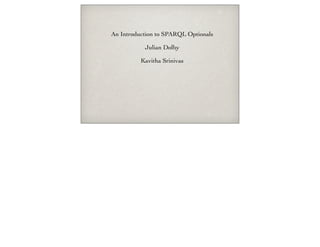

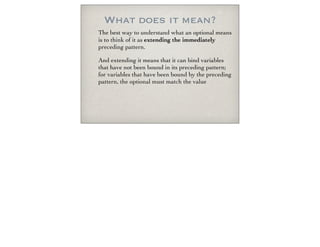


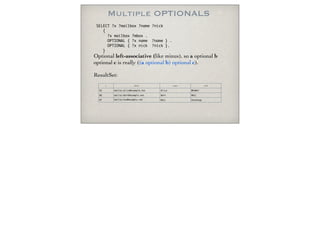



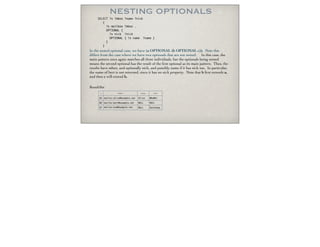
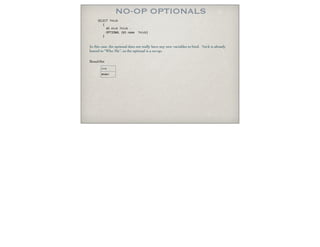
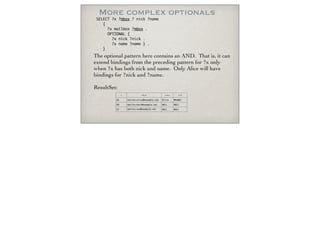
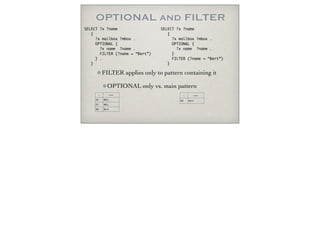
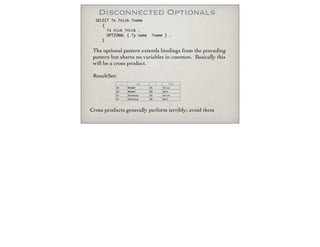
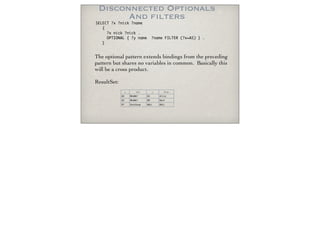
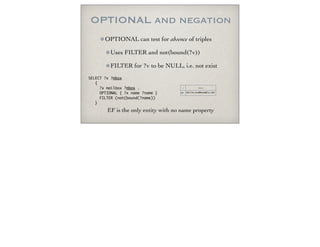
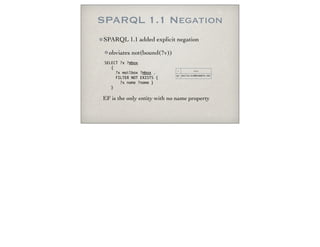

Ad
Recommended
Data Engineer's Lunch #81: Reverse ETL Tools for Modern Data Platforms
Data Engineer's Lunch #81: Reverse ETL Tools for Modern Data PlatformsAnant Corporation
╠²
This document discusses building a modern open data platform using open source tools. It introduces Anant Corporation and their playbook, framework, and approach for designing data platforms. Various open source tools are presented for building distributed, real-time data platforms including Cassandra, Kafka, Airflow, and more. The document provides an overview of how to choose the right tools to optimize core capabilities, achieve business modularity, and connect business information systems.Les outils OLAPnadia sassi
╠²
Le document pr├®sente les outils OLAP, une cat├®gorie de technologies et d'applications permettant de collecter et analyser des donn├®es multidimensionnelles ├Ā des fins d├®cisionnelles. Il aborde les structures OLAP, les op├®rations de manipulation des donn├®es, ainsi que les diff├®rents types d'outils et de mod├©les OLAP disponibles sur le march├®. Enfin, il conclut sur la flexibilit├® et l'efficacit├® des syst├©mes OLAP pour am├®liorer la productivit├® au sein des organisations.BigData_Chp1: Introduction a╠Ć la Big DataLilia Sfaxi
╠²
Le document traite des big data, en soulignant qu'ils repr├®sentent une quantit├® massive de donn├®es g├®n├®r├®es quotidiennement, dont 90% sont non structur├®es. Il met ├®galement en avant les avantages, d├®fis et caract├®ristiques des big data, notamment les 5 V : volume, vari├®t├®, vitesse, v├®racit├® et valeur. Enfin, le texte aborde l'importance de ces donn├®es pour les entreprises afin de prendre des d├®cisions inform├®es et d'am├®liorer leur comp├®titivit├®.Base de donn├®es NoSQLOussama ARBI
╠²
Le document pr├®sente une analyse approfondie des bases de donn├®es NoSQL, d├®crivant leur d├®finition, classification et comparaison avec les bases de donn├®es SQL. Il aborde diff├®rents types de bases NoSQL, y compris orient├® cl├®/valeur, orient├® document, orient├® colonne et orient├® graphe, tout en soulignant leurs caract├®ristiques et cas d'utilisation. Enfin, des benchmarks de performance entre plusieurs syst├©mes NoSQL sont discut├®s pour ├®valuer leur efficacit├® dans divers sc├®narios de charge de travail.6.hive
6.hivePrashant Gupta
╠²
Apache Hive is a data warehousing tool built on Hadoop designed for data analysis of structured data, using a language similar to SQL called HiveQL. It executes queries on a Hadoop infrastructure, allowing it to handle large datasets, while also requiring specific configurations for effective use, such as choosing the correct execution engine and configuring the metastore. The document also details installation, data types, table management, query structure, and best practices for using Hive.Data Platform Architecture Principles and Evaluation Criteria
Data Platform Architecture Principles and Evaluation CriteriaScyllaDB
╠²
The document outlines data platform architecture principles and evaluation criteria, emphasizing operational excellence, performance efficiency, and security. It discusses cloud migration, data modernization journeys, and various offerings by public cloud providers for implementing data platforms. Additionally, it includes evaluation metrics and checkpoints to assess data operations and business requirements for successful data architecture implementations.Bases de Donn├®es non relationnelles, NoSQL (Introduction) 1er coursHatim CHAHDI
╠²
Le document pr├®sente un cours sur les bases de donn├®es NoSQL, en se concentrant sur les bases de donn├®es orient├®es graphes, telles que Neo4j. Il explique les motivations derri├©re l'utilisation des syst├©mes NoSQL, les diff├®rents types de bases de donn├®es NoSQL, ainsi que leurs caract├®ristiques et applications. Le cours souligne l'importance des graphes pour g├®rer des donn├®es interconnect├®es, en mettant en ├®vidence des exemples d'utilisation et des th├®ories sous-jacentes.Data Visualisation & Analytics with Tableau (Beginner) - by Maria Koumandraki
Data Visualisation & Analytics with Tableau (Beginner) - by Maria KoumandrakiOutreach Digital
╠²
This document outlines a 7 step process for creating data visualizations in Tableau. It includes an agenda, descriptions of each step, and demos. The 7 steps are: 1) Connecting to data, 2) Cleaning and preparing data, 3) Creating initial visualizations using Show Me or drag and drop, 4) Editing visualizations, 5) Analyzing data and creating additional visualizations, 6) Creating interactive dashboards, and 7) Sharing visualizations. The presenter leads attendees through examples on air pollution data and life expectancy data to demonstrate the process.Data Engineering Efficiency @ Netflix - Strata 2017
Data Engineering Efficiency @ Netflix - Strata 2017Michelle Ufford
╠²
The document discusses the evolution of data engineering efficiency at Netflix, highlighting the transition from traditional maintenance tasks to more automated and intelligent processes. It outlines various strategies for simplifying and automating data maintenance, quality, and insight to enhance overall data engineering performance. The author reflects on observed changes and future developments aimed at achieving greater efficiency in data engineering operations.Domain Driven Design Made Functional with Python
Domain Driven Design Made Functional with Python Jean Carlo Machado
╠²
This document discusses using domain modeling with types in Python using the static type checker Mypy. It motivates the use of types for domain-driven design and functional programming concepts. It then provides examples of building blocks for Mypy's type system algebra, including simple values with new types, combinations of values, modeling choices with unions, type functions, classes, generics, and putting the concepts together in a workflow. It also discusses limitations of Mypy and resources for further learning. The overall goal is to leave the reader inspired to learn more about applying type systems to domain modeling.Les Base de Donn├®es NOSQL -Presentation -IliasAEA
╠²
Ce document pr├®sente une introduction aux bases de donn├®es NoSQL, mettant en avant leurs diff├®rences par rapport aux bases de donn├®es relationnelles traditionnelles, notamment en mati├©re de scalabilit├® et de gestion des donn├®es. Il aborde les concepts fondamentaux comme ACID et BASE, ainsi que les types de bases de donn├®es NoSQL comme les bases de donn├®es cl├®-valeur, documentaires, de colonnes et graphiques. Enfin, il explore les d├®fis li├®s ├Ā l'informatique distribu├®e et le th├®or├©me CAP qui stipule que dans les syst├©mes de bases de donn├®es distribu├®, il est impossible de garantir simultan├®ment coh├®rence, disponibilit├® et tol├®rance aux partitions.Big Data and Machine Learning with FIWARE
Big Data and Machine Learning with FIWAREFernando Lopez Aguilar
╠²
The document provides an overview of big data and machine learning within the FIWARE framework, covering topics such as Apache Flink and Spark, ETL architecture, and machine learning algorithms. It details the integration of FIWARE components, including the Orion Context Broker, with big data tools and addresses the development lifecycle of machine learning. Additionally, it includes references for further reading and resources related to FIWARE and its connectors.Functional Domain Modeling - The ZIO 2 Way
Functional Domain Modeling - The ZIO 2 WayDebasish Ghosh
╠²
The document discusses domain modeling in problem-solving and software engineering, focusing on the definition, vocabulary, and structures of a domain model. It emphasizes the use of ZIO (a Scala library) for functional programming, detailing how to implement repositories and services that facilitate persistent object management and transaction handling. Key concepts include the separation of domain logic, the use of effects, and the benefits of a declarative service wiring through ZLayers.Intro to HBase
Intro to HBasealexbaranau
╠²
This document introduces HBase, an open-source, non-relational, distributed database modeled after Google's BigTable. It describes what HBase is, how it can be used, and when it is applicable. Key points include that HBase stores data in columns and rows accessed by row keys, integrates with Hadoop for MapReduce jobs, and is well-suited for large datasets, fast random access, and write-heavy applications. Common use cases involve log analytics, real-time analytics, and messages-centered systems.Data Lakehouse, Data Mesh, and Data Fabric (r2)
Data Lakehouse, Data Mesh, and Data Fabric (r2)James Serra
╠²
The document discusses various modern data architectures including data warehouses, data lakes, data mesh, and data fabric, explaining their purposes and functionalities. It provides an overview of advantages and reasons to implement these systems, highlighting the differences between centralized and decentralized data management approaches. The author emphasizes the importance of understanding these architectures to make informed decisions regarding data strategy and infrastructure.BigData_Chp2: Hadoop & Map-ReduceLilia Sfaxi
╠²
Le document pr├®sente l'architecture et le fonctionnement du framework Hadoop, qui comprend le syst├©me de fichiers distribu├® HDFS et le mod├©le de traitement MapReduce. HDFS permet de stocker de grandes quantit├®s de donn├®es sur un cluster, tandis que MapReduce facilite le traitement parall├©le de ces donn├®es. Plusieurs outils et composants, tels que YARN et des biblioth├©ques comme Pig et Hive, viennent compl├®ter Hadoop pour simplifier l'extraction, le stockage et le traitement des donn├®es.Data Warehouse Design and Best Practices
Data Warehouse Design and Best PracticesIvo Andreev
╠²
The document outlines best practices for data warehouse design, discussing various architectures like Inmon and Kimball models, as well as key concepts such as dimensional modeling, ETL processes, and data maintenance strategies. It emphasizes the importance of data quality, integrity, and effective design patterns for ensuring efficient data management and retrieval. The document also includes practical considerations and pitfalls to avoid in data warehousing to achieve successful business intelligence outcomes.SQL to Hive Cheat Sheet
SQL to Hive Cheat SheetHortonworks
╠²
The document is a comprehensive guide for SQL users transitioning to Hadoop with Apache Hive, which is a data warehouse infrastructure built on Hadoop. It includes a cheat sheet for HiveQL (Hive Query Language) with SQL syntax equivalents for various operations, alongside additional resources for learning Hive. Users can access tutorials and services related to Hadoop and Hive through provided links.Les interface graphiques sous androidHoussem Lahiani
╠²
Le document pr├®sente un cours sur la programmation d'interfaces graphiques sous Android, en abordant diff├®rents types de layouts tels que LinearLayout, RelativeLayout, AbsoluteLayout et TableLayout. Chaque type de layout est d├®crit en d├®tail, incluant des propri├®t├®s essentielles comme l'orientation, le positionnement et la taille des ├®l├®ments. La s├®paration entre le code Java et la d├®finition XML des interfaces est ├®galement soulign├®e, soulignant l'importance de la clart├® et de la maintenabilit├® du code.Introduction to HiveQL
Introduction to HiveQLkristinferrier
╠²
The document introduces HiveQL, a SQL-like querying language for Apache Hadoop, designed for analyzing large datasets using tables. It details the components of Hadoop, the differences between HiveQL and traditional SQL, and offers guidance on getting started with Hive and importing data. Resources for further learning and tutorials are also provided, including references to playground environments and detailed documentation.Data Catalog for Better Data Discovery and Governance
Data Catalog for Better Data Discovery and GovernanceDenodo
╠²
The document discusses the importance of a data catalog for improving data discovery and governance, highlighting its role in providing a user-centric experience for accessing data. It outlines key features such as a Google-like search interface, data sharing capabilities, and integration with external tools, aimed at empowering users to navigate and validate data effectively. The catalog fosters collaboration and helps bridge the gap between reporting tools and underlying data models.DEVOPS - La synth├©seCOMPETENSIS
╠²
Le document explore la m├®thodologie DevOps, qui fusionne les pratiques de d├®veloppement et d'op├®ration pour am├®liorer la productivit├® et la qualit├® des services IT en int├®grant des concepts de lean manufacturing et d'agilit├®. Il souligne les enjeux, les contraintes et l'├®volution historique de DevOps, indiquant son ├®mergence face aux d├®fis de modernisation des infrastructures IT. DevOps vise une collaboration fluide entre les ├®quipes, favorisant l'automatisation et la responsabilisation des d├®veloppeurs pour garantir la stabilit├® et la disponibilit├® des syst├©mes.Introduction to MongoDB.pptx
Introduction to MongoDB.pptxSurya937648
╠²
The document provides an introduction and overview of MongoDB, including what NoSQL is, the different types of NoSQL databases, when to use MongoDB, its key features like scalability and flexibility, how to install and use basic commands like creating databases and collections, and references for further learning.Why Data Vault?
Why Data Vault? Kent Graziano
╠²
The document discusses the data vault modeling methodology, emphasizing its flexibility, scalability, and productivity for enterprise data warehouses. It highlights how data vault architecture addresses challenges faced with traditional models like 3NF and star schema, enabling rapid changes and integration of varying data sources. Key benefits include reduced complexity in ETL processes, enhanced audit capabilities, and a growing adoption rate among organizations, showcasing its effectiveness in modern data warehousing practices.Introduction ├Ā Neo4jNeo4j
╠²
Neo4j est un acteur majeur dans le domaine des graphes, offrant des solutions pour l'analyse des donn├®es et l'int├®gration des relations entre celles-ci. La base de donn├®es native de graphes permet une exploitation efficace des connexions, influen├¦ant les d├®cisions dans divers secteurs, tels que la finance, la sant├® et la logistique. Avec un mod├©le flexible et des algorithmes avanc├®s, Neo4j favorise l'innovation et la personnalisation dans l'analyse des donn├®es ├Ā grande ├®chelle.Data Analysis Expressions (DAX) Training
Data Analysis Expressions (DAX) TrainingArocom IT Solutions Pvt. Ltd
╠²
This document contains confidential information from Arocom Solutions Private Limited intended only for the addressee. It discusses an upcoming training on Data Analysis Expressions (DAX), Power Query, and Power BI. The agenda includes introductions, an overview of DAX and how it differs from Excel, common DAX functions, calculated columns and measures, and exercises. DAX is a functional formula language for data analysis within Excel data models that allows for aggregation, filtering, and time intelligence operations.Building an Enterprise Eventing Framework (Bryan Zelle, Centene; Neil Buesing...
Building an Enterprise Eventing Framework (Bryan Zelle, Centene; Neil Buesing...confluent
╠²
Centene aims to enhance its enterprise eventing platform to support its rapid growth driven by mergers and acquisitions, facing challenges in data integration and migration. The platform will leverage asynchronous pub/sub messaging with Kafka for scalability and real-time data transfer, facilitating insight-driven decisions in healthcare operations. The document outlines Centene's strategic partnerships and the need for a customized real-time eventing solution that meets its specific requirements.Yarn by default (Spark on YARN)
Yarn by default (Spark on YARN)Ferran Gal├Ł Reniu
╠²
The document discusses the integration of Spark with YARN for big data processing, highlighting the importance of the Hadoop Distributed File System (HDFS) and the infrastructure needed to manage data pipelines effectively. It covers the architecture of YARN, MapReduce, and Spark jobs, along with configuration details and resource management strategies such as static and dynamic allocation of resources. The author also shares insights into the deployment process and performance enhancements for big data applications.Home Theater: Surround Sound Formats
Home Theater: Surround Sound FormatsCurt Robbins
╠²
The document discusses various surround sound formats used in home theater systems, detailing the differences between matrixed and discrete formats, such as Dolby and DTS standards. It explains how certain standards transform stereo audio into multi-channel surround sound, enhancing the listening experience by utilizing all speakers. Additionally, it highlights the importance of choosing the right audio standard for different types of entertainment, emphasizing benefits like true discrete surround sound and lossless audio options.Surround sount system
Surround sount systemChetan Gakhare
╠²
The seminar on surround sound systems covered the fundamentals of surround sound, including its evolution, various channel configurations like 5.1 and 7.1, and technical specifications for design and application in home theaters. It discussed the historical context of surround sound, starting from its use in the 1940 Disney film 'Fantasia' to modern formats such as Dolby Digital and DTS. The session concluded by emphasizing the accessibility and practicality of surround sound systems for consumers today.More Related Content
What's hot (20)
Data Engineering Efficiency @ Netflix - Strata 2017
Data Engineering Efficiency @ Netflix - Strata 2017Michelle Ufford
╠²
The document discusses the evolution of data engineering efficiency at Netflix, highlighting the transition from traditional maintenance tasks to more automated and intelligent processes. It outlines various strategies for simplifying and automating data maintenance, quality, and insight to enhance overall data engineering performance. The author reflects on observed changes and future developments aimed at achieving greater efficiency in data engineering operations.Domain Driven Design Made Functional with Python
Domain Driven Design Made Functional with Python Jean Carlo Machado
╠²
This document discusses using domain modeling with types in Python using the static type checker Mypy. It motivates the use of types for domain-driven design and functional programming concepts. It then provides examples of building blocks for Mypy's type system algebra, including simple values with new types, combinations of values, modeling choices with unions, type functions, classes, generics, and putting the concepts together in a workflow. It also discusses limitations of Mypy and resources for further learning. The overall goal is to leave the reader inspired to learn more about applying type systems to domain modeling.Les Base de Donn├®es NOSQL -Presentation -IliasAEA
╠²
Ce document pr├®sente une introduction aux bases de donn├®es NoSQL, mettant en avant leurs diff├®rences par rapport aux bases de donn├®es relationnelles traditionnelles, notamment en mati├©re de scalabilit├® et de gestion des donn├®es. Il aborde les concepts fondamentaux comme ACID et BASE, ainsi que les types de bases de donn├®es NoSQL comme les bases de donn├®es cl├®-valeur, documentaires, de colonnes et graphiques. Enfin, il explore les d├®fis li├®s ├Ā l'informatique distribu├®e et le th├®or├©me CAP qui stipule que dans les syst├©mes de bases de donn├®es distribu├®, il est impossible de garantir simultan├®ment coh├®rence, disponibilit├® et tol├®rance aux partitions.Big Data and Machine Learning with FIWARE
Big Data and Machine Learning with FIWAREFernando Lopez Aguilar
╠²
The document provides an overview of big data and machine learning within the FIWARE framework, covering topics such as Apache Flink and Spark, ETL architecture, and machine learning algorithms. It details the integration of FIWARE components, including the Orion Context Broker, with big data tools and addresses the development lifecycle of machine learning. Additionally, it includes references for further reading and resources related to FIWARE and its connectors.Functional Domain Modeling - The ZIO 2 Way
Functional Domain Modeling - The ZIO 2 WayDebasish Ghosh
╠²
The document discusses domain modeling in problem-solving and software engineering, focusing on the definition, vocabulary, and structures of a domain model. It emphasizes the use of ZIO (a Scala library) for functional programming, detailing how to implement repositories and services that facilitate persistent object management and transaction handling. Key concepts include the separation of domain logic, the use of effects, and the benefits of a declarative service wiring through ZLayers.Intro to HBase
Intro to HBasealexbaranau
╠²
This document introduces HBase, an open-source, non-relational, distributed database modeled after Google's BigTable. It describes what HBase is, how it can be used, and when it is applicable. Key points include that HBase stores data in columns and rows accessed by row keys, integrates with Hadoop for MapReduce jobs, and is well-suited for large datasets, fast random access, and write-heavy applications. Common use cases involve log analytics, real-time analytics, and messages-centered systems.Data Lakehouse, Data Mesh, and Data Fabric (r2)
Data Lakehouse, Data Mesh, and Data Fabric (r2)James Serra
╠²
The document discusses various modern data architectures including data warehouses, data lakes, data mesh, and data fabric, explaining their purposes and functionalities. It provides an overview of advantages and reasons to implement these systems, highlighting the differences between centralized and decentralized data management approaches. The author emphasizes the importance of understanding these architectures to make informed decisions regarding data strategy and infrastructure.BigData_Chp2: Hadoop & Map-ReduceLilia Sfaxi
╠²
Le document pr├®sente l'architecture et le fonctionnement du framework Hadoop, qui comprend le syst├©me de fichiers distribu├® HDFS et le mod├©le de traitement MapReduce. HDFS permet de stocker de grandes quantit├®s de donn├®es sur un cluster, tandis que MapReduce facilite le traitement parall├©le de ces donn├®es. Plusieurs outils et composants, tels que YARN et des biblioth├©ques comme Pig et Hive, viennent compl├®ter Hadoop pour simplifier l'extraction, le stockage et le traitement des donn├®es.Data Warehouse Design and Best Practices
Data Warehouse Design and Best PracticesIvo Andreev
╠²
The document outlines best practices for data warehouse design, discussing various architectures like Inmon and Kimball models, as well as key concepts such as dimensional modeling, ETL processes, and data maintenance strategies. It emphasizes the importance of data quality, integrity, and effective design patterns for ensuring efficient data management and retrieval. The document also includes practical considerations and pitfalls to avoid in data warehousing to achieve successful business intelligence outcomes.SQL to Hive Cheat Sheet
SQL to Hive Cheat SheetHortonworks
╠²
The document is a comprehensive guide for SQL users transitioning to Hadoop with Apache Hive, which is a data warehouse infrastructure built on Hadoop. It includes a cheat sheet for HiveQL (Hive Query Language) with SQL syntax equivalents for various operations, alongside additional resources for learning Hive. Users can access tutorials and services related to Hadoop and Hive through provided links.Les interface graphiques sous androidHoussem Lahiani
╠²
Le document pr├®sente un cours sur la programmation d'interfaces graphiques sous Android, en abordant diff├®rents types de layouts tels que LinearLayout, RelativeLayout, AbsoluteLayout et TableLayout. Chaque type de layout est d├®crit en d├®tail, incluant des propri├®t├®s essentielles comme l'orientation, le positionnement et la taille des ├®l├®ments. La s├®paration entre le code Java et la d├®finition XML des interfaces est ├®galement soulign├®e, soulignant l'importance de la clart├® et de la maintenabilit├® du code.Introduction to HiveQL
Introduction to HiveQLkristinferrier
╠²
The document introduces HiveQL, a SQL-like querying language for Apache Hadoop, designed for analyzing large datasets using tables. It details the components of Hadoop, the differences between HiveQL and traditional SQL, and offers guidance on getting started with Hive and importing data. Resources for further learning and tutorials are also provided, including references to playground environments and detailed documentation.Data Catalog for Better Data Discovery and Governance
Data Catalog for Better Data Discovery and GovernanceDenodo
╠²
The document discusses the importance of a data catalog for improving data discovery and governance, highlighting its role in providing a user-centric experience for accessing data. It outlines key features such as a Google-like search interface, data sharing capabilities, and integration with external tools, aimed at empowering users to navigate and validate data effectively. The catalog fosters collaboration and helps bridge the gap between reporting tools and underlying data models.DEVOPS - La synth├©seCOMPETENSIS
╠²
Le document explore la m├®thodologie DevOps, qui fusionne les pratiques de d├®veloppement et d'op├®ration pour am├®liorer la productivit├® et la qualit├® des services IT en int├®grant des concepts de lean manufacturing et d'agilit├®. Il souligne les enjeux, les contraintes et l'├®volution historique de DevOps, indiquant son ├®mergence face aux d├®fis de modernisation des infrastructures IT. DevOps vise une collaboration fluide entre les ├®quipes, favorisant l'automatisation et la responsabilisation des d├®veloppeurs pour garantir la stabilit├® et la disponibilit├® des syst├©mes.Introduction to MongoDB.pptx
Introduction to MongoDB.pptxSurya937648
╠²
The document provides an introduction and overview of MongoDB, including what NoSQL is, the different types of NoSQL databases, when to use MongoDB, its key features like scalability and flexibility, how to install and use basic commands like creating databases and collections, and references for further learning.Why Data Vault?
Why Data Vault? Kent Graziano
╠²
The document discusses the data vault modeling methodology, emphasizing its flexibility, scalability, and productivity for enterprise data warehouses. It highlights how data vault architecture addresses challenges faced with traditional models like 3NF and star schema, enabling rapid changes and integration of varying data sources. Key benefits include reduced complexity in ETL processes, enhanced audit capabilities, and a growing adoption rate among organizations, showcasing its effectiveness in modern data warehousing practices.Introduction ├Ā Neo4jNeo4j
╠²
Neo4j est un acteur majeur dans le domaine des graphes, offrant des solutions pour l'analyse des donn├®es et l'int├®gration des relations entre celles-ci. La base de donn├®es native de graphes permet une exploitation efficace des connexions, influen├¦ant les d├®cisions dans divers secteurs, tels que la finance, la sant├® et la logistique. Avec un mod├©le flexible et des algorithmes avanc├®s, Neo4j favorise l'innovation et la personnalisation dans l'analyse des donn├®es ├Ā grande ├®chelle.Data Analysis Expressions (DAX) Training
Data Analysis Expressions (DAX) TrainingArocom IT Solutions Pvt. Ltd
╠²
This document contains confidential information from Arocom Solutions Private Limited intended only for the addressee. It discusses an upcoming training on Data Analysis Expressions (DAX), Power Query, and Power BI. The agenda includes introductions, an overview of DAX and how it differs from Excel, common DAX functions, calculated columns and measures, and exercises. DAX is a functional formula language for data analysis within Excel data models that allows for aggregation, filtering, and time intelligence operations.Building an Enterprise Eventing Framework (Bryan Zelle, Centene; Neil Buesing...
Building an Enterprise Eventing Framework (Bryan Zelle, Centene; Neil Buesing...confluent
╠²
Centene aims to enhance its enterprise eventing platform to support its rapid growth driven by mergers and acquisitions, facing challenges in data integration and migration. The platform will leverage asynchronous pub/sub messaging with Kafka for scalability and real-time data transfer, facilitating insight-driven decisions in healthcare operations. The document outlines Centene's strategic partnerships and the need for a customized real-time eventing solution that meets its specific requirements.Yarn by default (Spark on YARN)
Yarn by default (Spark on YARN)Ferran Gal├Ł Reniu
╠²
The document discusses the integration of Spark with YARN for big data processing, highlighting the importance of the Hadoop Distributed File System (HDFS) and the infrastructure needed to manage data pipelines effectively. It covers the architecture of YARN, MapReduce, and Spark jobs, along with configuration details and resource management strategies such as static and dynamic allocation of resources. The author also shares insights into the deployment process and performance enhancements for big data applications.Viewers also liked (8)
Home Theater: Surround Sound Formats
Home Theater: Surround Sound FormatsCurt Robbins
╠²
The document discusses various surround sound formats used in home theater systems, detailing the differences between matrixed and discrete formats, such as Dolby and DTS standards. It explains how certain standards transform stereo audio into multi-channel surround sound, enhancing the listening experience by utilizing all speakers. Additionally, it highlights the importance of choosing the right audio standard for different types of entertainment, emphasizing benefits like true discrete surround sound and lossless audio options.Surround sount system
Surround sount systemChetan Gakhare
╠²
The seminar on surround sound systems covered the fundamentals of surround sound, including its evolution, various channel configurations like 5.1 and 7.1, and technical specifications for design and application in home theaters. It discussed the historical context of surround sound, starting from its use in the 1940 Disney film 'Fantasia' to modern formats such as Dolby Digital and DTS. The session concluded by emphasizing the accessibility and practicality of surround sound systems for consumers today.Dolby Laboratories Pitch
Dolby Laboratories PitchMatthew R. Thomas
╠²
The document provides an investment thesis for Dolby Laboratories, summarizing its market opportunities, company overview, and financial performance. It highlights the potential for revenue growth through partnerships and the standardization of technologies like Dolby Vision and Atmos, particularly in the growing Chinese market. The recommendation is to buy the stock with a projected upside in various market scenarios.Dolby atmos-cinema-technical-guidelines
Dolby atmos-cinema-technical-guidelinesDigital Innovation Groupware - Industries Techniques
╠²
This white paper provides guidelines for installing and positioning loudspeakers in cinemas for Dolby Atmos playback. It recommends screen and surround speaker placement including elevation and aiming. Additional surround speakers are added closer to the screen and overhead to enable precise sound positioning. Optimal spatial resolution is achieved by keeping the angular distance between adjacent speakers below 30 degrees. Bass management redirects low frequencies from surrounds to subwoofers at the rear to maintain consistent timbre across all speakers.Top Indian Brands on Social Media - June 2013
Top Indian Brands on Social Media - June 2013Unmetric
╠²
This document analyzes and compares the performance of top Indian brands across social media platforms like Facebook, Twitter, and YouTube. It provides statistics on key metrics like audience, engagement, growth, content strategy, and competitive analysis for brands in different sectors like automotive, consumer electronics, food and beverages, retail, etc. Some high performing brands highlighted include Hyundai, Samsung, KitKat, Flipkart, HDFC Life, and Micromax. The document also discusses specific campaigns and videos by brands that performed well. It aims to help readers understand how brands are using social media and identify who is leading engagement in different sectors.Dolby atmos explained
Dolby atmos explainedWaqar Zahoor
╠²
Dolby Atmos is a 3D surround sound technology launched in 2012 that places audio devices and speakers overhead to produce sound that comes from all directions. It analyzes which sounds should come from which speakers placed around the cinema, including on the ceiling above the audience. Last year, many home cinema manufacturers announced products to bring Dolby Atmos to home theaters, with receivers and speakers from brands like Denon, Onkyo, and Yamaha. While commercial theaters use many more speakers, home versions can add 2-4 ceiling speakers to create the 3D effect with help from Dolby Atmos decoding receivers.Oscars 2016: Winners and Highlights
Oscars 2016: Winners and Highlightsmaditabalnco
╠²
The document provides photos and captions from the 2016 Academy Awards ceremony. Some of the key details summarized are:
- Photos show various award winners including Leonardo DiCaprio, Brie Larson, Spotlight producers, and others posing with their Oscars.
- Photos also show performances by Lady Gaga, The Weeknd, and a tribute to David Bowie during the In Memorium segment.
- Additional photos show nominees like Matt Damon, Jennifer Lawrence, Eddie Redmayne, and others arriving at the ceremony wearing designer gowns and suits.║▌║▌▀Żshare ppt
║▌║▌▀Żshare pptMandy Suzanne
╠²
Miss goodheart created a PowerPoint to test out the ║▌║▌▀Żshare tool, which was introduced to her by Sharon Tonner on January 20th, 2011.Ad
Recently uploaded (20)
Securing Account Lifecycles in the Age of Deepfakes.pptx
Securing Account Lifecycles in the Age of Deepfakes.pptxFIDO Alliance
╠²
Securing Account Lifecycles in the Age of DeepfakesRaman Bhaumik - Passionate Tech Enthusiast
Raman Bhaumik - Passionate Tech EnthusiastRaman Bhaumik
╠²
A Junior Software Developer with a flair for innovation, Raman Bhaumik excels in delivering scalable web solutions. With three years of experience and a solid foundation in Java, Python, JavaScript, and SQL, she has streamlined task tracking by 20% and improved application stability.UserCon Belgium: Honey, VMware increased my bill
UserCon Belgium: Honey, VMware increased my billstijn40
╠²
VMwareŌĆÖs pricing changes have forced organizations to rethink their datacenter cost management strategies. While FinOps is commonly associated with cloud environments, the FinOps Foundation has recently expanded its framework to include ScopesŌĆöand Datacenter is now officially part of the equation. In this session, weŌĆÖll map the FinOps Framework to a VMware-based datacenter, focusing on cost visibility, optimization, and automation. YouŌĆÖll learn how to track costs more effectively, rightsize workloads, optimize licensing, and drive efficiencyŌĆöall without migrating to the cloud. WeŌĆÖll also explore how to align IT teams, finance, and leadership around cost-aware decision-making for on-prem environments. If your VMware bill keeps increasing and you need a new approach to cost management, this session is for you!Enhance GitHub Copilot using MCP - Enterprise version.pdf
Enhance GitHub Copilot using MCP - Enterprise version.pdfNilesh Gule
╠²
║▌║▌▀Ż deck related to the GitHub Copilot Bootcamp in Melbourne on 17 June 2025GenAI Opportunities and Challenges - Where 370 Enterprises Are Focusing Now.pdf
GenAI Opportunities and Challenges - Where 370 Enterprises Are Focusing Now.pdfPriyanka Aash
╠²
GenAI Opportunities and Challenges - Where 370 Enterprises Are Focusing NowWebdriverIO & JavaScript: The Perfect Duo for Web Automation
WebdriverIO & JavaScript: The Perfect Duo for Web Automationdigitaljignect
╠²
In todayŌĆÖs dynamic digital landscape, ensuring the quality and dependability of web applications is essential. While Selenium has been a longstanding solution for automating browser tasks, the integration of WebdriverIO (WDIO) with Selenium and JavaScript marks a significant advancement in automation testing. WDIO enhances the testing process by offering a robust interface that improves test creation, execution, and management. This amalgamation capitalizes on the strengths of both tools, leveraging SeleniumŌĆÖs broad browser support and WDIOŌĆÖs modern, efficient approach to test automation. As automation testing becomes increasingly vital for faster development cycles and superior software releases, WDIO emerges as a versatile framework, particularly potent when paired with JavaScript, making it a preferred choice for contemporary testing teams.PyCon SG 25 - Firecracker Made Easy with Python.pdf
PyCon SG 25 - Firecracker Made Easy with Python.pdfMuhammad Yuga Nugraha
╠²
Explore the ease of managing Firecracker microVM with the firecracker-python. In this session, I will introduce the basics of Firecracker microVM and demonstrate how this custom SDK facilitates microVM operations easily. We will delve into the design and development process behind the SDK, providing a behind-the-scenes look at its creation and features. While traditional Firecracker SDKs were primarily available in Go, this module brings a simplicity of Python to the table." How to survive with 1 billion vectors and not sell a kidney: our low-cost c...
" How to survive with 1 billion vectors and not sell a kidney: our low-cost c...Fwdays
╠²
Let's talk about our history. How we started the project with a small vector database of less than 2 million records. Later, we received a request for +100 million records, then another +100... And so gradually we reached almost 1 billion. Standard tools were quickly running out of steam - we were running into performance, index size, and very limited resources. After a long series of trials and errors, we built our own low-cost cluster, which today stably processes thousands of queries to more than 1B vectors.Using the SQLExecutor for Data Quality Management: aka One man's love for the...
Using the SQLExecutor for Data Quality Management: aka One man's love for the...Safe Software
╠²
The SQLExecutor is one of FMEŌĆÖs most powerful and flexible transformers. Pivvot maintains a robust internal metadata hierarchy used to support ingestion and curation of thousands of external data sources that must be managed for quality before entering our platform. By using the SQLExecutor, Pivvot can efficiently detect problems and perform analysis before data is extracted from our staging environment, removing the need for rollbacks or cycles waisted on a failed job. This presentation will walk through three distinct examples of how Pivvot uses the SQLExecutor to engage its metadata hierarchy and integrate with its Data Quality Management workflows efficiently and within the source postgres database. Spatial Validation ŌĆōValidating spatial prerequisites before entering a production environment. Reference Data Validation - Dynamically validate domain-ed columns across any table and multiple columns per table. Practical De-duplication - Removing identical or near-identical well point locations from two distinct source datasets in the same table.Wenn alles versagt - IBM Tape sch├╝tzt, was z├żhlt! Und besonders mit dem neust...
Wenn alles versagt - IBM Tape sch├╝tzt, was z├żhlt! Und besonders mit dem neust...Josef Weingand
╠²
IBM LTO10Cracking the Code - Unveiling Synergies Between Open Source Security and AI.pdf
Cracking the Code - Unveiling Synergies Between Open Source Security and AI.pdfPriyanka Aash
╠²
Cracking the Code - Unveiling Synergies Between Open Source Security and AISmarter Aviation Data Management: Lessons from Swedavia Airports and Sweco
Smarter Aviation Data Management: Lessons from Swedavia Airports and SwecoSafe Software
╠²
Managing airport and airspace data is no small task, especially when youŌĆÖre expected to deliver it in AIXM format without spending a fortune on specialized tools. But what if there was a smarter, more affordable way?
Join us for a behind-the-scenes look at how Sweco partnered with Swedavia, the Swedish airport operator, to solve this challenge using FME and Esri.
Learn how they built automated workflows to manage periodic updates, merge airspace data, and support data extracts ŌĆō all while meeting strict government reporting requirements to the Civil Aviation Administration of Sweden.
Even better? Swedavia built custom services and applications that use the FME Flow REST API to trigger jobs and retrieve results ŌĆō streamlining tasks like securing the quality of new surveyor data, creating permdelta and baseline representations in the AIS schema, and generating AIXM extracts from their AIS data.
To conclude, FME expert Dean Hintz will walk through a GeoBorders reading workflow and highlight recent enhancements to FMEŌĆÖs AIXM (Aeronautical Information Exchange Model) processing and interpretation capabilities.
Discover how airports like Swedavia are harnessing the power of FME to simplify aviation data management, and how you can too.The Future of Product Management in AI ERA.pdf
The Future of Product Management in AI ERA.pdfAlyona Owens
╠²
Hi, IŌĆÖm Aly Owens, I have a special pleasure to stand here as over a decade ago I graduated from CityU as an international student with an MBA program. I enjoyed the diversity of the school, ability to work and study, the network that came with being here, and of course the price tag for students here has always been more affordable than most around.
Since then I have worked for major corporations like T-Mobile and Microsoft and many more, and I have founded a startup. I've also been teaching product management to ensure my students save time and money to get to the same level as me faster avoiding popular mistakes. Today as IŌĆÖve transitioned to teaching and focusing on the startup, I hear everybody being concerned about Ai stealing their jobsŌĆ” WeŌĆÖll talk about it shortly.
But before that, I want to take you back to 1997. One of my favorite movies is ŌĆ£Fifth ElementŌĆØ. It wowed me with futuristic predictions when I was a kid and IŌĆÖm impressed by the number of these predictions that have already come true. Self-driving cars, video calls and smart TV, personalized ads and identity scanning. Sci-fi movies and books gave us many ideas and some are being implemented as we speak. But we often get ahead of ourselves:
Flying cars,Colonized planets, Human-like AI: not yet, Time travel, Mind-machine neural interfaces for everyone: Only in experimental stages (e.g. Neuralink).
Cyberpunk dystopias: Some vibes (neon signs + inequality + surveillance), but not total dystopia (thankfully).
On the bright side, we predict that the working hours should drop as Ai becomes our helper and there shouldnŌĆÖt be a need to work 8 hours/day. Nobody knows for sure but we can require that from legislation. Instead of waiting to see what the government and billionaires come up with, I say we should design our own future.
So, we as humans, when we donŌĆÖt know something - fear takes over. The same thing happened during the industrial revolution. In the Industrial Era, machines didnŌĆÖt steal jobsŌĆöthey transformed them but people were scared about their jobs. The AI era is making similar changes except it feels like robots will take the center stage instead of a human. First off, even when it comes to the hottest space in the military - drones, Ai does a fraction of work. AI algorithms enable real-time decision-making, obstacle avoidance, and mission optimization making drones far more autonomous and capable than traditional remote-controlled aircraft. Key technologies include computer vision for object detection, GPS-enhanced navigation, and neural networks for learning and adaptation. But guess what? There are only 2 companies right now that utilize Ai in drones to make autonomous decisions - Skydio and DJI.
OpenPOWER Foundation & Open-Source Core Innovations
OpenPOWER Foundation & Open-Source Core InnovationsIBM
╠²
penPOWER offers a fully open, royalty-free CPU architecture for custom chip design.
It enables both lightweight FPGA cores (like Microwatt) and high-performance processors (like POWER10).
Developers have full access to source code, specs, and tools for end-to-end chip creation.
It supports AI, HPC, cloud, and embedded workloads with proven performance.
Backed by a global community, it fosters innovation, education, and collaboration."Scaling in space and time with Temporal", Andriy Lupa.pdf
"Scaling in space and time with Temporal", Andriy Lupa.pdfFwdays
╠²
Design patterns like Event Sourcing and Event Streaming have long become standards for building real-time analytics systems. However, when the system load becomes nonlinear with fast and often unpredictable spikes, it's crucial to respond quickly in order not to lose real-time operating itself.
In this talk, IŌĆÖll share my experience implementing and using a tool like Temporal.io. We'll explore the evolution of our system for maintaining real-time report generation and discuss how we use Temporal both for short-lived pipelines and long-running background tasks.Curietech AI in action - Accelerate MuleSoft development
Curietech AI in action - Accelerate MuleSoft developmentshyamraj55
╠²
CurieTech AI in Action ŌĆō Accelerate MuleSoft Development
Overview:
This presentation demonstrates how CurieTech AIŌĆÖs purpose-built agents empower MuleSoft developers to create integration workflows faster, more accurately, and with less manual effort
linkedin.com
+12
curietech.ai
+12
meetups.mulesoft.com
+12
.
Key Highlights:
Dedicated AI agents for every stage: Coding, Testing (MUnit), Documentation, Code Review, and Migration
curietech.ai
+7
curietech.ai
+7
medium.com
+7
DataWeave automation: Generate mappings from tables or samplesŌĆö95%+ complete within minutes
linkedin.com
+7
curietech.ai
+7
medium.com
+7
Integration flow generation: Auto-create Mule flows based on specificationsŌĆöspeeds up boilerplate development
curietech.ai
+1
medium.com
+1
Efficient code reviews: Gain intelligent feedback on flows, patterns, and error handling
youtube.com
+8
curietech.ai
+8
curietech.ai
+8
Test & documentation automation: Auto-generate MUnit test cases, sample data, and detailed docs from code
curietech.ai
+5
curietech.ai
+5
medium.com
+5
Why Now?
Achieve 10├Ś productivity gains, slashing development time from hours to minutes
curietech.ai
+3
curietech.ai
+3
medium.com
+3
Maintain high accuracy with code quality matching or exceeding manual efforts
curietech.ai
+2
curietech.ai
+2
curietech.ai
+2
Ideal for developers, architects, and teams wanting to scale MuleSoft projects with AI efficiency
Conclusion:
CurieTech AI transforms MuleSoft development into an AI-accelerated workflowŌĆöletting you focus on innovation, not repetition.Lessons Learned from Developing Secure AI Workflows.pdf
Lessons Learned from Developing Secure AI Workflows.pdfPriyanka Aash
╠²
Lessons Learned from Developing Secure AI WorkflowsTechniques for Automatic Device Identification and Network Assignment.pdf
Techniques for Automatic Device Identification and Network Assignment.pdfPriyanka Aash
╠²
Techniques for Automatic Device Identification and Network AssignmentOpenACC and Open Hackathons Monthly Highlights June 2025
OpenACC and Open Hackathons Monthly Highlights June 2025OpenACC
╠²
The OpenACC organization focuses on enhancing parallel computing skills and advancing interoperability in scientific applications through hackathons and training. The upcoming 2025 Open Accelerated Computing Summit (OACS) aims to explore the convergence of AI and HPC in scientific computing and foster knowledge sharing. This year's OACS welcomes talk submissions from a variety of topics, from Using Standard Language Parallelism to Computer Vision Applications. The document also highlights several open hackathons, a call to apply for NVIDIA Academic Grant Program and resources for optimizing scientific applications using OpenACC directives.Ad
Using SPARQL Optionals
- 1. An Introduction to SPARQL Optionals Julian Dolby Kavitha Srinivas
- 2. Why Do We Need OPTIONALS? Deals with sparsity in graph data. A simple example where this is useful: John age 42 John lastName Smith John spouse Mary John homeState New_York New_York isIn NorthEast Todd age 42 Todd lastName Doe Todd homeState Connecticut Connecticut isIn NorthEast Tom age 42 Say we want to ’¼ünd all the people who are aged 42 and live in the NorthEast, and optionally their spouses names, if its known. OPTIONAL allows you to express that.
- 3. What does it mean? The best way to understand what an optional means is to think of it as extending the immediately preceding pattern. And extending it means that it can bind variables that have not been bound in its preceding pattern; for variables that have been bound by the preceding pattern, the optional must match the value
- 4. A working dataset AS mailbox mailto:alice@example.net AS name Alice AS nick WhoMe? BD mailbox mailto:bert@example.net BD name Bert EF mailbox mailto:eve@example.net EF nick DuckSoup Many of the examples here are from JenaŌĆÖs ARQ suite
- 5. The SIMPLEST CASE Simplest case: optional pattern extends bindings from the preceding pattern, and provides binding for 'name' in the OPTIONAL pattern. ResultSet: SELECT ?x ?mbox ?name { ?x mailbox ?mbox . OPTIONAL { ?x name ?name } . } x mbox name AS mailto:alice@example.net Alice BD mailto:bert@example.net Bert EF mailto:eve@example.net NULL
- 6. Multiple OPTIONALS Optional left-associative (like minus), so a optional b optional c is really ((a optional b) optional c). ResultSet: SELECT ?x ?mailbox ?name ?nick { ?x mailbox ?mbox . OPTIONAL { ?x name ?name } . OPTIONAL { ?x nick ?nick }. } x mbox name nick AS mailto:alice@example.net Alice WhoMe? BD mailto:bert@example.net Bert NULL EF mailto:eve@example.net NULL DuckSoup
- 7. Multiple OPTIONALS Contd. Note that the second optional binds values to a variable bound by another optional. Thus, the inner pattern will bind x, mbox and optionally label. If it binds label, then the outer pattern has to match it and cannot extend it. So result will have all mbox properties, and all name properties that have an mbox. The outer pattern extends these results. If a subject has no name property, then any nick property for it will be returned. If it does have a name property, then a nick property will be returned only if its target matches a name property for the same subject. However, only label is projected. So then, if there is a name property, label will be bound to that. If not, then it will bind any nick property. Thus, for Alice, we should see the name and no nickname. ResultSet SELECT ?label { ?x mailbox ?mbox . OPTIONAL { ?x name ?label } . OPTIONAL { ?x nick ?label } . } Label Alice Bert DuckSoup AS, BD, EF all have mailboxes. All should match for main. Optional 1: Extends with name for AS and BD, null for EF. Optional 2: Extends optional 1 result set with nickname for EF, since for the AS and BD, nick HAS to match bindings of label in optional 1.
- 8. Multiple OPTIONALS Contd. SELECT ?label { ?x mailbox ?mbox . OPTIONAL { ?x name ?label } . OPTIONAL { ?x nick ?label } . } SELECT ?label { ?x mailbox ?mbox . OPTIONAL { { ?x name ?label } UNION { ?x nick ?label } . } } Multiple OPTIONAL clauses binding the same variable is similar to yet subtly different from a UNION inside the OPTIONAL. The lefthand query gets ŌĆśnickŌĆÖ labels for mailboxes that have no ŌĆśnameŌĆÖ; the righthand query gets all ŌĆśnickŌĆÖ and ŌĆśnameŌĆÖ labels for any mailbox. Label Alice Bert DuckSoup Label Alice Bert DuckSoup WhoMe? Multiple OPTIONAL clauses binding the same variable is rarely what you want
- 9. OPTIONAL WITH EMPTY Here, no pattern to extend (i.e., the pattern is empty). An empty pattern binds no variables, so the optional ŌĆśextendsŌĆÖ the empty result set with any of its variables. Note this is equivalent to dropping the OPTIONAL altogether. ResultSet: SELECT ?x ?nick { OPTIONAL { ?x nick ?nick }. } x nick AS WhoMe? EF DuckSoup
- 10. NESTING OPTIONALS In the nested optional case, we have (a OPTIONAL (b OPTIONAL c)). Note this differs from the case where we have two optionals that are not nested. In this case, the main pattern once again matches all three individuals, but the optionals being nested means the second optional has the result of the ’¼ürst optional as its main pattern. Thus, the results have mbox, and optionally nick, and possibly name if it has nick too. In particular, the name of bert is not returned, since it has no nick property. Note that b ’¼ürst extends a, and then c will extend b. ResultSet SELECT ?x ?mbox ?name ?nick { ?x mailbox ?mbox . OPTIONAL { ?x nick ?nick OPTIONAL { ?x name ?name } } } x mbox name nick AS mailto:alice@example.net Alice WhoMe? BD mailto:bert@example.net NULL NULL EF mailto:eve@example.net NULL DuckSoup
- 11. NO-OP OPTIONALS In this case, the optional does not really have any new variables to bind. ?nick is already bound to ŌĆ£Who MeŌĆØ, so the optional is a no-op. ResultSet SELECT ?nick { AS nick ?nick . OPTIONAL {AS name ?nick} } nick WhoMe?
- 12. More complex optionals The optional pattern here contains an AND. That is, it can extend bindings from the preceding pattern for ?x only when ?x has both nick and name. Only Alice will have bindings for ?nick and ?name. ResultSet: SELECT ?x ?mbox ? nick ?name { ?x mailbox ?mbox . OPTIONAL { ?x nick ?nick . ?x name ?name } . } x mbox name nick AS mailto:alice@example.net Alice WhoMe? BD mailto:bert@example.net NULL NULL EF mailto:eve@example.net NULL NULL
- 13. OPTIONAL and FILTER FILTER applies only to pattern containing it OPTIONAL only vs. main pattern SELECT ?x ?name { ?x mailbox ?mbox . OPTIONAL { ?x name ?name . FILTER (?name = ŌĆ£BertŌĆØ) } . } SELECT ?x ?name { ?x mailbox ?mbox . OPTIONAL { ?x name ?name . } FILTER (?name = ŌĆ£BertŌĆØ) } x name AS NULL EF NULL BD Bert x name BD Bert
- 14. Disconnected Optionals The optional pattern extends bindings from the preceding pattern but shares no variables in common. Basically this will be a cross product. ResultSet: SELECT ?x ?nick ?name { ?x nick ?nick . OPTIONAL { ?y name ?name } . } x nick y Name AS WhoMe? AS Alice AS WhoMe? BD Bert EF DuckSoup AS Alice EF DuckSoup BD Bert Cross products generally perform terribly; avoid them
- 15. Disconnected Optionals And filters The optional pattern extends bindings from the preceding pattern but shares no variables in common. Basically this will be a cross product. ResultSet: SELECT ?x ?nick ?name { ?x nick ?nick . OPTIONAL { ?y name ?name FILTER (?x=AS) } . } x nick y Name AS WhoMe? AS Alice AS WhoMe? BD Bert EF DuckSoup NULL NULL
- 16. OPTIONAL and negation OPTIONAL can test for absence of triples Uses FILTER and not(bound(?v)) FILTER for ?v to be NULL, i.e. not exist SELECT ?x ?mbox { ?x mailbox ?mbox . OPTIONAL { ?x name ?name } FILTER (not(bound(?name)) } x mbox EF mailto:eve@example.net EF is the only entity with no name property
- 17. SPARQL 1.1 Negation SPARQL 1.1 added explicit negation obviates not(bound(?v)) SELECT ?x ?mbox { ?x mailbox ?mbox . FILTER NOT EXISTS { ?x name ?name } } x mbox EF mailto:eve@example.net EF is the only entity with no name property
- 18. SPARQL 1.1 Minus MINUS computes set difference expresses some forms of negation SELECT ?x ?mbox { ?x mailbox ?mbox . MINUS { ?x name ?name } } x mbox EF mailto:eve@example.net subtract entities with name from entities with mailbox
